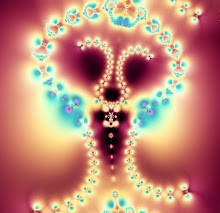Pitcher. Fractal created by Jenny. Used Fractal Explorer.
A pitcher plant is a carnivorous plant (also called as Insectivorous plant). Carnivorous plants are plants that eat insects and other small animals. Carnivorous plants grow in soil that has little nitrogen. All living things must have nitrogen. Carnivorous plants get nitrogen from the insects they eat.
The pitcher of the pitcher plant is actually a modified leaf. The apex of the leaf is the lid. Pitcher plants catch (get) insects in a cup of liquid. The walls of the cup make nectar (sweet liquid) . The nectar attracts insects. When an insect lands on the wall, it falls down into the liquid. The insect cannot get out of the cup because the walls are smooth and slippery and the walls have hairs pointing down.
After the insect is dead, its body rots. Rotting releases (lets loose) the nitrogen from the insect's body. The nitrogen then goes into the liquid and the plant takes in the nitrogen from the liquid.
It is widely assumed pitfall traps evolved by epiascidiation (infolding of the leaf with the adaxial or upper surface becoming the inside of the pitcher), with selection pressure favouring more deeply cupped leaves over evolutionary time. The pitcher trap evolved independently in three eudicot lineages and one monocot lineage, representing a case of convergent evolution. Some pitcher plant families (such as Nepenthaceae) are placed within clades consisting mostly of flypaper traps, indicating that some pitchers may have evolved from the common ancestors of today's flypaper traps by loss of mucilage.
Foraging, flying, or crawling insects such as flies are attracted to a cavity formed by the cupped leaf, often by visual lures such as anthocyanin pigments, and nectar. The rim of the pitcher (peristome) is slippery when moistened by condensation or nectar, causing insects to fall into the trap. Pitcher plants may also contain waxy scales, protruding aldehyde crystals, cuticular that insects cannot climb out.[1] The small bodies of liquid contained within the pitcher traps are called phytotelmata. They drown the insect, whose body is gradually dissolved. This may occur by bacterial action (the bacteria being washed into the pitcher by rainfall), or by enzymes secreted by the plant itself. Furthermore, some pitcher plants contain mutualistic insect larvae, which feed on trapped prey, and whose excreta the plant absorbs.[5] Whatever the mechanism of digestion, the prey items are converted into a solution of amino acids, peptides, phosphates, ammonium and urea, from which the plant obtains its mineral nutrition (particularly nitrogen and phosphorus). Like all carnivorous plants, they all grow in locations where the soil is too poor in minerals and/or too acidic for most plants to survive. Pitcher plants supplement available nutrients and minerals (which plants normally obtain through their roots) with the constituents of their insect prey.
Mature plants of Nepenthes lowii attract tree shrews (Tupaia montana), which feed on nectar that the plant produces but also defecate into the pitcher, providing nitrates and other nutrients. The plant and tree shrew have a symbiotic relationship. The rim of N. lowii is not slippery so that tree shrews can easily get in and out; it provides more nectar than other pitcher plants. The shape of the pitcher rim and the position of the nectar ensure that the animal's hindquarters are over the rim while it feeds.









0 Comments:
Post a Comment